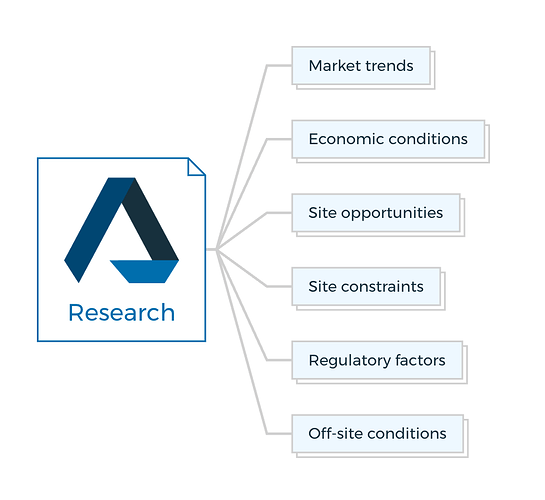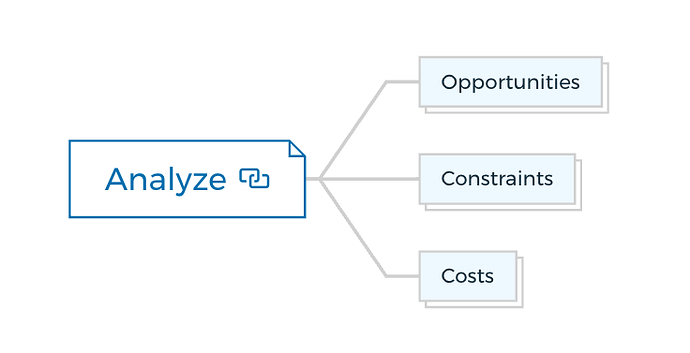Land Development - Overview
- Develop a New Concept for the Upcoming Project
- Align the Project Concept with an Appropriate Location
- Conduct an Initial Market Feasibility Analysis Including a Preliminary Site Plan, Financial Assessment, and Regulatory Examination
- Obtain Financial Backing Through Commitments from Banks or Investors
- Perform Comprehensive Site Analysis, Develop a Master Plan, and Prepare Engineering Designs and Detailed Specifications
- Secure All Necessary Regulatory Approvals for the Project
- Carry Out a Detailed Feasibility Study Incorporating Total Direct and Indirect Cost Estimates and Financial Viability Analysis
- Begin Marketing Efforts, Sales Activities, and the Construction of Site Developments
To conduct a comprehensive research covering market trends, economic conditions, site opportunities, site constraints, regulatory factors, and off-site conditions, you would follow these steps:
-
Market Trends:
- Analyze current and forecasted trends in the market related to the development project. This includes understanding consumer behavior, demand in the specific sector (residential, commercial, industrial, etc.), and technological advancements.
- Review industry reports, market analysis publications, and relevant news articles. Consider the impact of global events on market trends.
-
Economic Conditions:
- Examine the broader economic environment, including interest rates, employment rates, GDP growth, and inflation rates. Understanding these conditions can help predict market stability and investment viability.
- Utilize resources from economic research organizations, government economic data, financial news sources, and economic forecasts.
-
Site Opportunities:
- Identify the unique advantages of the site, such as location, accessibility, proximity to amenities or key infrastructure, and any existing facilities that can be leveraged.
- Engage with local planning departments, real estate databases, and geographic information system (GIS) tools to gather comprehensive data on the site.
-
Site Constraints:
- Assess potential limitations or challenges associated with the site, including environmental restrictions, zoning laws, topographical challenges, and existing land use.
- Conduct site visits, consult with local authorities, and review environmental impact assessments and zoning maps.
-
Regulatory Factors:
- Investigate all relevant local, state, and federal regulations that could impact the development project. This includes zoning laws, building codes, environmental regulations, and permitting requirements.
- Consult with legal experts in real estate and land use, and liaise with government officials to ensure comprehensive understanding and compliance.
-
Off-site Conditions:
- Evaluate conditions surrounding the site that may affect the project, such as infrastructure, neighboring properties, community impact, and environmental concerns.
- Use a combination of field assessments, community meetings, and collaboration with urban planners and civil engineers to gather necessary information.
In land development, synthesizing the analysis of opportunities, constraints, and costs is crucial for creating a comprehensive and strategic development plan. The interplay between these factors significantly influences the feasibility, design, and ultimate success of a project. Here’s how these factors affect each other and potential solutions that address multiple factors:
Learn More
Analyze
Analyzing the opportunities, constraints, and costs associated with land development involves a detailed and multifaceted approach. Here’s how you can break down each aspect:
Opportunities
Market Demand
Identify the current and projected demand for the type of development you’re considering (residential, commercial, mixed-use, etc.). Analyze demographic trends, economic indicators, and market saturation levels to gauge potential success.
Location Benefits
Evaluate how the location of the land adds value. Consider proximity to amenities, transportation networks, schools, and other infrastructure that can attract tenants or buyers.
Zoning and Land Use Policies
Understand the local zoning ordinances and land use policies to identify permissible types of developments that can maximize the land’s value.
Sustainability and Innovation
Assess the potential for sustainable development practices and innovative designs that could provide a competitive edge and attract eco-conscious buyers or tenants.
Constraints
Environmental Restrictions
Identify any environmental constraints, such as flood zones, wetlands, endangered species habitats, or contamination, which could limit development options or necessitate remediation.
Zoning Limitations
Review the zoning laws applicable to the land, which may restrict building sizes, heights, densities, or types of allowable uses.
Infrastructure Adequacy
Evaluate the existing infrastructure’s capacity, including roads, water supply, sewage, and utilities, to support the development. Major upgrades can significantly impact costs and timelines.
Community Opposition
Consider the potential for community opposition, which can delay projects through protests, lawsuits, or demands for extensive modifications to the proposed development.
Costs
Acquisition Costs
The purchase price of the land itself, including any costs related to closing the transaction.
Site Preparation Costs
Expenses related to making the land suitable for development, such as demolition, clearing, grading, and the installation of necessary infrastructure.
Regulatory Compliance Costs
Fees associated with obtaining permits, environmental assessments, and any other regulatory requirements. This also includes legal fees for navigating the regulatory landscape.
Construction Costs
The expenses of actual construction, including materials, labor, and management. This varies widely depending on the project scale, complexity, and local labor rates.
Financing Costs
Interest payments and other financing fees associated with borrowing money for the project.
Marketing and Selling Expenses
Costs related to marketing the development to potential buyers or tenants, including advertising and real estate commissions.
Analyzing these aspects requires a combination of market research, consultations with experts (such as urban planners, environmental consultants, and civil engineers), and financial modeling. Understanding the balance of opportunities, constraints, and costs will guide strategic decision-making and help ensure the viability and success of the land development project.
Interplay Between Factors
Opportunities and Constraints
Opportunities such as market demand and location benefits can be affected by constraints like environmental restrictions and zoning limitations. A high-demand area might have strict zoning laws that limit development types or densities, requiring creative planning and design solutions to maximize the site’s potential while adhering to regulations.
Opportunities and Costs
The opportunity to develop a high-value project in a prime location comes with higher land acquisition and construction costs. Financial feasibility becomes a critical consideration, balancing potential revenue against these costs to ensure profitability.
Constraints and Costs
Environmental constraints, zoning laws, and infrastructure inadequacies can increase development costs. Addressing these constraints often requires additional studies, mitigation efforts, and infrastructure upgrades, impacting the overall budget and financial model of the project.
Synthesized Solutions
Mixed-Use Developments
- Combining residential, commercial, and recreational spaces in a single development can address market demand for integrated living spaces while optimizing land use within zoning constraints. This approach can also spread development costs across multiple revenue streams, improving financial viability.
Sustainable and Green Building Practices
- Incorporating sustainable design and construction practices can mitigate environmental constraints and appeal to eco-conscious buyers or tenants. These practices can also lead to long-term cost savings through energy efficiency and may qualify for tax incentives or reduced regulatory fees.
Public-Private Partnerships (PPPs)
- Engaging in partnerships with local governments can provide solutions to infrastructure and zoning constraints. PPPs can facilitate access to public financing options, subsidies, or expedited permitting processes, reducing overall project costs and risks.
Adaptive Reuse of Existing Structures
- In areas with high environmental or historical preservation constraints, repurposing existing buildings can reduce site preparation and construction costs while maintaining compliance with regulatory standards. This approach also offers unique marketing opportunities by preserving the character of the site.
Phased Development Plans
- Implementing a phased development strategy allows for gradual investment, reducing initial financial burdens and adapting to changing market conditions over time. This approach can also help in managing infrastructure upgrades and regulatory compliance in stages, aligning costs with project milestones and revenue generation.
Community Engagement and Feedback
- Early and ongoing engagement with the local community can identify potential opposition and incorporate community needs into the project design. This proactive approach can streamline the regulatory approval process and enhance the project’s market appeal, balancing costs with community benefits.
Developers can devise innovative solutions that enhance project viability, meet regulatory requirements, and respond to market demands by thoughtfully synthesising the opportunities, constraints, and costs. This holistic approach is key to navigating the complexities of land development successfully.
Test Your Knowledge
Objective
To create a detailed project plan for a new land development initiative, incorporating market analysis, site analysis, financial planning, regulatory compliance, and strategic development solutions.
Develop a New Concept for the Upcoming Project
- Choose a type of development project (residential, commercial, industrial, mixed-use, etc.).
- Describe the concept and objectives of your project, including the target market and intended use.
- Align the Project Concept with an Appropriate Location:
- Identify a specific location for your project. Describe why this location is suitable based on accessibility, demographics, and proximity to amenities or infrastructure.
Conduct an Initial Market Feasibility Analysis
Market Trends
Research and summarize current and forecasted market trends affecting your chosen project type and location. Utilize industry reports and market analysis publications.
Economic Conditions
Assess the broader economic environment’s impact on your project, including interest rates and GDP growth.
Preliminary Site Plan and Financial Assessment: Draft a preliminary site plan. Outline key financial aspects, including estimated costs and potential revenue streams.
Regulatory Examination
Identify local, state, and federal regulations relevant to your project. Discuss potential challenges and how you plan to address them.
Obtain Financial Backing
Draft a proposal to secure financial backing. Include key elements of your market feasibility analysis and preliminary financial assessment to present to potential banks or investors.
Perform Comprehensive Site Analysis
Site Opportunities and Constraints
Conduct a detailed analysis of the site, identifying opportunities and constraints. Use GIS tools, site visits, and consultations with local authorities.
Develop a Master Plan and Engineering Designs: Based on your site analysis, develop a master plan for your project. Outline the engineering designs and detailed specifications required.
Secure All Necessary Regulatory Approvals
Create a checklist of all necessary regulatory approvals needed for your project. Outline the steps you will take to obtain these approvals.
Carry Out a Detailed Feasibility Study
Incorporate total direct and indirect cost estimates into a comprehensive feasibility study. Analyze the financial viability of the project in detail.
Begin Marketing and Sales Activities
Develop a marketing strategy for your project. Identify your target audience and the channels through which you will reach them.
Research Questions
- How do global events impact market trends relevant to your project?
- What sustainable and green building practices can be incorporated into your project to address environmental constraints?
- How can public-private partnerships (PPPs) be utilized to overcome infrastructure and zoning constraints?
To Do’s
- Compile your findings, analyses, and plans into a comprehensive report.
- Include visual aids (e.g., site plans, SWOT analysis, financial charts) to enhance your presentation.
- Prepare a 10-minute presentation summarizing your project plan and key findings.
Submission Requirements
- A written report of your project plan (15-20 pages, including appendices for detailed analyses).
- A PowerPoint presentation (10-15 slides).




